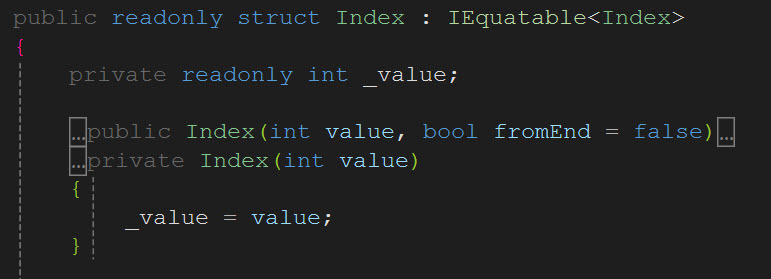Dissecting C# Ranges
This post is part of 2023 C# Advent! Be sure to check every day for new posts from the .NET community!
Recently, I was teaching C# to a group of developers. When I got to the topic of ranges, I was surprised at how much nuance there was. In this post, I don’t want to go into all of the features of ranges. That is covered in other places. I want to look at the structure of ranges to see that we can learn about them.
Grab a scalpel, lets slice one open.
Here is an example of a simple range. In case the range is accessing an array of numbers from index 3 to the index 3 from the end.
This works because integer arrays, like many other collections, have a range access property. You can easily add range access to your types by creating a property named ‘this’ that takes a Range as a parameter.
But what exactly is a Range? As you can see from its definition pictured below, it is a struct whose primary pieces of data are a start value and an end value.
But the data type of start and end isn’t int, it is Index. So, what is an index? It is a struct whose primary pieces of data are a value and flag indicating whether or not the value is measured from the end of the collection.
Going back to the original line of code, we can see that the caret is the indicator to the compiler whether or not the fromEnd property on the Index is true.
We can use the Syntax Visualizer in Visual Studio to see how the compiler thinks of Ranges. Range Expressions (1) are wrapped in a BracketedArgumentList. They contain the start expression, the aptly named DotDotToken, and the end expression. In this case, the start expression is a NumericLiteralExpression(2) and the end expression is a IndexExpression(3). As you can see, the IndexExpression contains a CaretToken and a NumericLiteralExpression.
Why doesn’t the start token need to be an IndexExpression? While the compiler can do all kinds of tricks, it helps that the Index type contains an implicit conversion from int to Index.
We have yet to begin to dig into the functionality of Ranges, but I hope this look at their structure gives us a little more understanding of how they work.
Comments Section
Feel free to comment on the post but keep it clean and on topic.
comments powered by DisqusAbout Me
![]() My name is Eric Potter. I have an amazing wife and 5 wonderful children. I am a Microsoft MVP for Developer Tools and Technologies, the Director of Technical Education for Sweetwater in Ft. Wayne Indiana, and an adjunct professor for Indiana Tech. I am a humble toolsmith.
My name is Eric Potter. I have an amazing wife and 5 wonderful children. I am a Microsoft MVP for Developer Tools and Technologies, the Director of Technical Education for Sweetwater in Ft. Wayne Indiana, and an adjunct professor for Indiana Tech. I am a humble toolsmith.

pottereric.github.com





